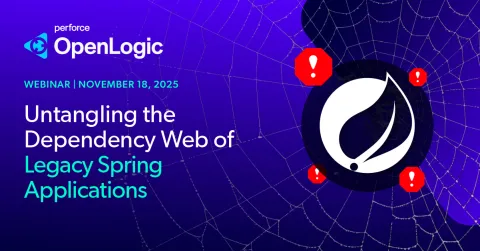Blog
October 16, 2025
The Spring Framework Lifecycle Challenge: Move Fast or Stay Stable?
Spring,
Java
While Spring’s rapid evolution is one of its greatest strengths, it can also become a strain on enterprise teams managing hundreds of services, complex dependency graphs, and strict uptime requirements. Staying current on Spring Framework means having access to bug fixes and “latest and greatest” improvements, but moving too quickly can introduce instability and regressions.
In this blog, we’ll explore the Spring Framework lifecycle, and particularly how the changes that went into effect with the 6.0 release will impact teams. We'll also discuss what makes Spring Framework upgrades so challenging for large organizations, and how to keep your application(s) secure on end-of-life versions until you are ready to migrate.
Understanding the Spring Framework Lifecycle
Whereas some open source software includes multi-year or even decade-long support, the Spring community decided in 2022 to align their releases with OpenJDK and shorten their community support window. Starting with 6.x, Spring Framework now follows a time-based release and support model, with a major or minor version being released every six months (usually in May and November), and each version is typically supported for about 12–18 months. Community support includes bug fixes, security patches, and compatibility updates. After that window, community support goes away and organizations are responsible for maintaining older versions if they can’t, or don’t want, to upgrade.
Let's consider some of the pros and cons of this change:
Benefits of the New Release Model
- Time-driven, not scope-driven: Releases are scheduled around fixed timelines rather than waiting for feature completion.
- Alignment with OpenJDK: The schedule tracks OpenJDK’s six-month release cycle, enabling faster adoption of new Java capabilities.
- Quicker feedback loop: Frequent releases give developers earlier access to improvements and new features.
- Cloud-native focus: Enhancements such as improved native image support and AOT compilation are delivered more consistently, leading to smaller, faster applications well-suited for cloud environments.
Drawbacks of the Faster Cadence
While the shift provides predictability and agility, it introduces challenges for both developers and enterprises that rely on slower, controlled upgrade cycles.
Developer and Team Challenges
- Upgrade pressure: Teams may feel constant pressure to adopt new versions to stay current with features and maintain compatibility with the Java ecosystem.
- Shorter support lifespans: Faster releases reduce the support window for older versions, increasing maintenance overhead.
- Risk of technical debt: Falling behind on upgrades can lead to accumulating debt, making future migrations more complex and costly.
Enterprise Challenges
- Longer adoption cycles: Large organizations, particularly in regulated industries, often cannot adopt updates quickly due to governance and compliance requirements.
- Extensive validation needs: New versions require broad testing, security checks, and coordination across multiple teams—efforts that become heavier with frequent releases.
- Rigid scheduling conflicts: Annual release dates may misalign with enterprise timelines, especially where internal policies limit major upgrades during peak operational periods.
The Spring Framework lifecycle modernizes the release approach by making continuous delivery a reality, but this inherently takes time from development cycles that advance application functionality and innovation. The fact is, more development time will become dedicated to maintenance upgrades and compliance to ensure alignment with a supported version of the underlying development framework.
Consequently, some teams may decide to remain on older Spring Framework versions. Of course, when a Spring Framework version reaches end-of-life, it doesn’t mean the application will immediately stop working. However, it does mean it is exposed — to security risks, dependency drift, and compliance issues if you’re in a regulated industry. Technical debt and compatibility issues will also accumulate if you put off upgrading for too long.
Back to top
What Makes Spring Framework Upgrades Complex?
Upgrading the Spring Framework isn’t just about swapping jars or updating Maven or Gradle coordinates. Each release can ripple through your application and dependency ecosystem in ways that require careful planning. You have to be ready to handle things like:
- Namespace changes: The move from
javax.*tojakarta.*in Spring 6.x breaks backward compatibility for many libraries. - Core API updates: Modifications to key Spring components, like transaction management or context initialization, may affect internal frameworks.
- Dependency alignment: Many internal and third-party libraries rely on older Spring APIs, creating a domino effect when planning upgrades.
- Additional updates: Making updates to Spring Framework often necessitates making updates to OpenJDK and Tomcat, which increases deployment risk.
As Spring engineers know all too well, even minor version changes can require comprehensive testing and dependency management to ensure stability.
Back to topWatch On-Demand
Image
Extending the Spring Framework Lifecycle
Organizations that cannot align with the community release cadence have a couple of options to extend support and maintain operational stability.
1. Commercial Distributions
In 2009, VMWare (now part of Broadcom) acquired SpringSource, the company behind Spring Framework, and they now sell a commercial version (Tanzu Spring) that extends security and maintenance coverage beyond the community support timeline. The downside is that the licensing/subscription fees are expensive and can increase at any time. Plus, there is risk of getting locked in to Broadcom/VMWare’s ecosystem of products and having less flexibility when it comes to other tools in your stack.
2. Long-Term Support (LTS)
There are vendors like OpenLogic that offer Spring Framework LTS, providing security patches, workarounds, and guidance after community EOL. LTS enables enterprises to:
- Maintain stability on mission-critical systems
- Reduce risk from vulnerabilities in older releases
- Plan upgrades/migrations when it makes sense for the business
- Take time to test and validate new features before adopting
The following chart shows how OpenLogic's long-term support extends the life of Spring Framework deployments:
| Version | Released | Community Support | OpenLogic LTS |
| Spring Framework 5.3 | October 2020 | Ended August 31, 2024 | Through October 31, 2027 |
| Spring Framework 6.1 | November 2023 | Ended June 30, 2025 | Through December 31, 2027 |
Planning Effective Spring Framework Upgrades
For organizations running enterprise applications on Spring Framework, upgrades are rarely simple, to say nothing of major version migrations. A strategic approach is necessary to reduce risk and avoid production outages. Here’s a high-level breakdown of key steps:
1. Assess Your Environment
- Inventory all applications using Spring Framework, including shared internal libraries.
- Identify dependencies that may block upgrades or require modification.
- Check Java version requirements for newer framework versions.
2. Coordinate Across Teams
- Ensure DevOps and QA teams have clear rollout and rollback plans.
- Confirm developers are aware of breaking changes in APIs, configuration, or dependencies.
- Validate integrations with downstream systems or partner libraries.
3. Leverage LTS Solutions
Spring Framework LTS gives you the runway to schedule upgrades when operationally safe, rather than rushing to meet the end-of-life deadline. This structured approach allows for proper testing, stakeholder alignment, and controlled deployment.
Back to topCase Study: API Platform Stays Secure and On Track With LTS
Modern enterprises rely on a complex web of APIs to handle critical operations — from financial transactions to customer-facing experiences. One of OpenLogic’s customers, an API Application Management Platform, depends heavily on the Spring Framework as the backbone of their core platform. Like many enterprises, they were running an older version of Spring when the framework’s release and support timelines shifted.
The team faced a difficult choice:
- Invest two full quarters upgrading the core framework and all dependent libraries, potentially delaying critical customer-facing features
- Risk falling out of compliance and security coverage, leaving the platform vulnerable to known issues
A rushed upgrade would have caused massive disruptions, impacting revenue, customer trust, and the delivery of essential features.
By adopting OpenLogic’s Spring LTS, the organization avoided this high-risk scenario. Within a single sprint, they pivoted to the supported LTS version — maintaining security, compliance, and operational stability while continuing to deliver mission-critical features.
The benefits were immediate and measurable:
- Saved an estimated 5,500–6,000 hours of work that would have gone into an emergency upgrade
- Maintained security coverage without forcing immediate updates
- Gained freedom to plan upgrades on their own terms
- Sidestepped dependency conflicts, budget overruns, and roadmap disruptions
With the breathing room provided by LTS, the platform can now plan a major framework upgrade strategically, reducing risk while keeping development focused on delivering value to customers.
Back to topFinal Thoughts
The Spring Framework is a rapidly evolving ecosystem that delivers valuable features and performance improvements with each release. However, enterprise teams must balance innovation with operational stability.
With a proactive lifecycle strategy and trusted long-term support partner, organizations can confidently manage the Spring Framework lifecycle — staying secure today while preparing for future upgrades so they are minimally disruptive.
Additional Resources
- Blog - Managing End-of-Life Spring Vulnerabilities
- Webinar - Taming Tomcat 11: Tips and Tricks for Java Teams
- Datasheet - Spring Boot and Spring Framework Long-Term Support
- Blog - 5 Reasons Why Companies Choose OpenLogic for OSS Support
- Blog - Planning Your Next Spring Boot Upgrade
- Blog - Spring Boot Monitoring in a Microservices World

